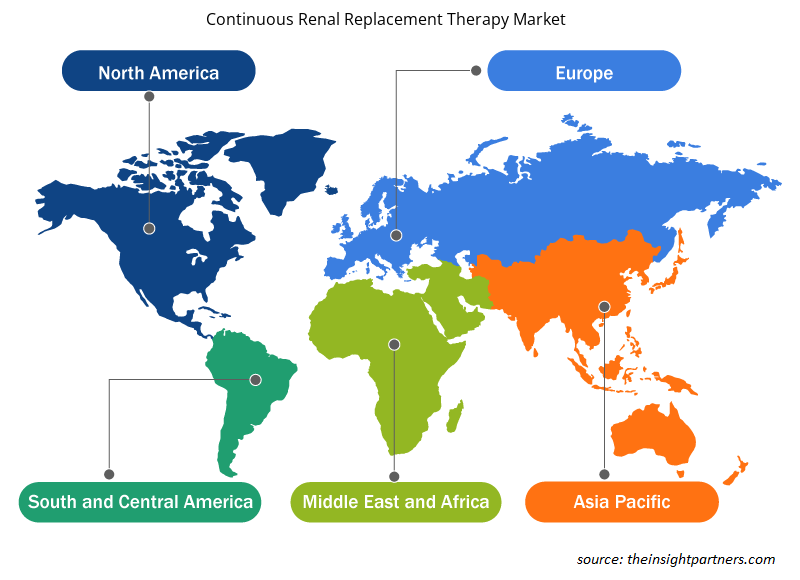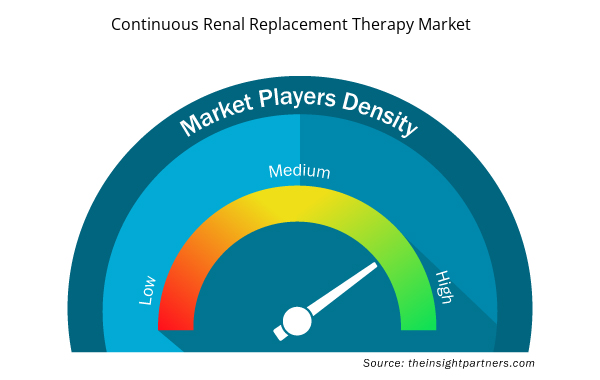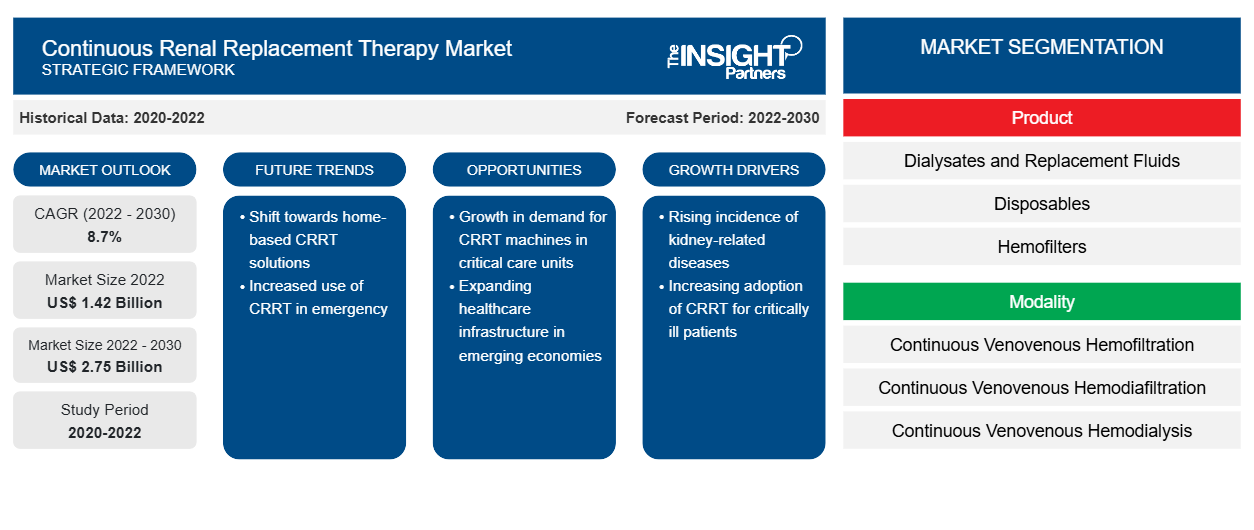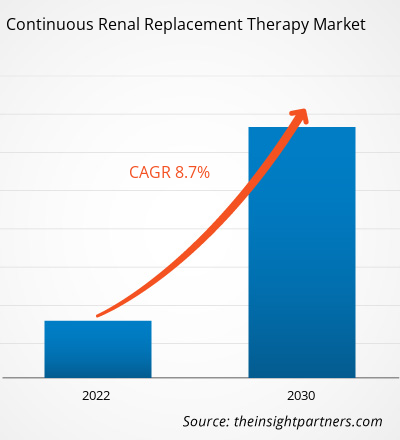[Rapport de recherche] La taille du marché de la thérapie de remplacement rénal continu devrait passer de 1,42 milliard de dollars américains en 2022 à 2,75 milliards de dollars américains d'ici 2030. Le marché devrait enregistrer un TCAC de 8,7 % de 2022 à 2030.
Informations sur le marché et point de vue des analystes :
Ce rapport comprend les perspectives de croissance en raison des tendances actuelles du marché de la thérapie de remplacement rénal continu et de leur impact prévisible au cours de la période de prévision.
La thérapie de remplacement rénal continu (TRRC) est une intervention vitale pour les patients souffrant d'insuffisance rénale aiguë sévère (IRA), de surcharge hydrique et d'urémie avec des anomalies métaboliques potentiellement mortelles. Des facteurs tels que la demande accrue de dispositifs de TRRC pédiatriques et la prévalence élevée de maladies chroniques conduisant à des maladies rénales propulsent la croissance du marché de la thérapie de remplacement rénal continu . Cependant, un risque important d'événement indésirable rénal majeur (MAKE) limite la croissance du marché.
Facteurs moteurs du marché :
Forte incidence de maladies chroniques conduisant à des maladies rénales
1 personne sur 10 dans le monde est touchée par une maladie rénale chronique (MRC), une maladie courante et potentiellement mortelle. De 2015 à 2019, le diabète et l'hypertension artérielle étaient les deux principales causes d'insuffisance rénale dans 75 % du total des cas d'insuffisance rénale. Selon les estimations publiées par la National Kidney Foundation en 2020, aux États-Unis, environ 30 % de la population diabétique de plus de 20 ans risque de développer une MRC au cours de sa vie. De plus, cette maladie a causé plus de décès que le cancer de la prostate ou le cancer du sein en 2020, et il s'agit d'un trouble de santé d'urgence sous-estimé. 1 adulte américain sur 3 (soit environ 80 millions de personnes) présente un risque de MRC, qui est désormais identifiée comme un facteur de risque clair d'AKI. Une diminution du débit de filtration glomérulaire (DFG) et une augmentation de la protéinurie sont fortement associées à une AKI.
Selon l'Institut national de la santé, l'incidence de l'AKI est en hausse dans les pays développés. Sa prévalence chez les patients hospitalisés devrait atteindre 15 %, et elle est plus élevée chez les patients gravement malades, soit 60 %. L'incidence de l'AKI chez les patients hospitalisés dans le monde entier varie de 0,7 % à 31 % ; les patients des unités de soins intensifs (USI) connaissent une incidence de plus de 50 %. Entre 3 % et 13 % des patients atteints d'AKI ont besoin d'une TRR et 40 % de ces patients auraient besoin d'une TRR pendant plus de 90 jours. Ainsi, la forte prévalence des maladies chroniques conduisant à des maladies rénales stimule la croissance continue du marché de la thérapie de remplacement rénal.
Les principaux effets indésirables associés à la CRRT comprennent l'hypotension, la tachycardie et d'autres arythmies, qui peuvent nuire à l'état du patient ou entraver sa guérison. De plus, le circuit CRRT pourrait faciliter l'élimination plus rapide des micronutriments, des oligo-éléments et/ou des médicaments thérapeutiques, ce qui peut entraîner des concentrations faibles ou irrégulières dans le sang et les tissus, provoquant ainsi des effets indésirables et/ou une perte d'effet thérapeutique. Ainsi, les effets indésirables limitent le marché de la thérapie de remplacement rénal continu.
Personnalisez ce rapport en fonction de vos besoins
Vous bénéficierez d'une personnalisation gratuite de n'importe quel rapport, y compris de certaines parties de ce rapport, d'une analyse au niveau des pays, d'un pack de données Excel, ainsi que de superbes offres et réductions pour les start-ups et les universités.
- Obtenez les principales tendances clés du marché de ce rapport.Cet échantillon GRATUIT comprendra une analyse de données, allant des tendances du marché aux estimations et prévisions.
Segmentation et portée du rapport :
L’analyse du marché de la thérapie de remplacement rénal continu a été réalisée en prenant en compte les segments suivants : produit, modalité et utilisateur final.
Analyse segmentaire :
Le marché de la thérapie de remplacement rénal continu, par produit, est segmenté en dialysats et liquides de remplacement, produits jetables, ensembles et tubes de perfusion sanguine, systèmes CRRT et hémofiltres. Le segment des systèmes CRRT représentait la plus grande part du marché en 2022. Le segment des hémofiltres devrait enregistrer le TCAC le plus élevé du marché au cours de la période 2022-2030.
Par modalité, le marché de la thérapie de remplacement rénal continu est segmenté en hémofiltration veino-veineuse continue (CVVH), hémodiafiltration veino-veineuse continue (CVVHDF), hémodialyse veino-veineuse continue (CVVHD) et ultrafiltration continue lente (SCUF). Le segment de l'hémofiltration veino-veineuse continue (CVVH) détenait la plus grande part du marché en 2022. Le marché du segment de l'hémodiafiltration veino-veineuse continue (CVVHDF) devrait enregistrer le TCAC le plus élevé au cours de la période 2022-2030.
En termes d'utilisateur final, le marché de la thérapie de remplacement rénal continu est segmenté en hôpitaux, centres de soins ambulatoires , soins à domicile et autres. En 2022, le segment des hôpitaux a dominé la part de marché de la thérapie de remplacement rénal continu. Cependant, le segment de la surveillance à domicile devrait enregistrer le TCAC le plus élevé au cours de la période 2022-2030.
Analyse régionale :
La portée du rapport sur le marché de la thérapie de remplacement rénal continu englobe l'Amérique du Nord (États-Unis, Canada et Mexique), l'Europe (Espagne, Royaume-Uni, Allemagne, France, Italie et reste de l'Europe), l'Asie-Pacifique (Corée du Sud, Chine, Inde, Japon, Australie et reste de l'Asie-Pacifique), le Moyen-Orient et l'Afrique (Afrique du Sud, Arabie saoudite, Émirats arabes unis et reste du Moyen-Orient et de l'Afrique) et l'Amérique du Sud et centrale (Brésil, Argentine et reste de l'Amérique du Sud et centrale).
En termes de chiffre d'affaires, en 2022, l'Amérique du Nord a dominé la part de marché de la thérapie de remplacement rénal continu. Le marché de l'Asie-Pacifique devrait enregistrer le TCAC le plus élevé au cours de la période 2022-2030. Le marché de la thérapie de remplacement rénal continu en Asie-Pacifique se développe grâce à l'amélioration des infrastructures de santé et à l'adoption de technologies CRRT innovantes, qui peuvent toutes deux être associées à une augmentation des dépenses de santé. En outre, les initiatives stratégiques des acteurs du marché visant à étendre leur présence en Asie-Pacifique, telles que les collaborations avec les prestataires de soins de santé locaux, favorisent la croissance du marché dans la région.
Aperçu régional du marché de la thérapie de remplacement rénal continu
Les tendances et facteurs régionaux influençant le marché de la thérapie de remplacement rénal continu tout au long de la période de prévision ont été expliqués en détail par les analystes d’Insight Partners. Cette section traite également des segments et de la géographie du marché de la thérapie de remplacement rénal continu en Amérique du Nord, en Europe, en Asie-Pacifique, au Moyen-Orient et en Afrique, ainsi qu’en Amérique du Sud et en Amérique centrale.

- Obtenez les données régionales spécifiques au marché de la thérapie de remplacement rénal continu
Portée du rapport sur le marché de la thérapie de remplacement rénal continu
| Attribut de rapport | Détails |
|---|---|
| Taille du marché en 2022 | 1,42 milliard de dollars américains |
| Taille du marché d'ici 2030 | 2,75 milliards de dollars américains |
| Taux de croissance annuel moyen mondial (2022-2030) | 8,7% |
| Données historiques | 2020-2022 |
| Période de prévision | 2022-2030 |
| Segments couverts | Par produit
|
| Régions et pays couverts | Amérique du Nord
|
| Leaders du marché et profils d'entreprises clés |
|
Densité des acteurs du marché de la thérapie de remplacement rénal continu : comprendre son impact sur la dynamique commerciale
Le marché de la thérapie de remplacement rénal continu connaît une croissance rapide, tirée par la demande croissante des utilisateurs finaux en raison de facteurs tels que l'évolution des préférences des consommateurs, les avancées technologiques et une plus grande sensibilisation aux avantages du produit. À mesure que la demande augmente, les entreprises élargissent leurs offres, innovent pour répondre aux besoins des consommateurs et capitalisent sur les tendances émergentes, ce qui alimente davantage la croissance du marché.
La densité des acteurs du marché fait référence à la répartition des entreprises ou des sociétés opérant sur un marché ou un secteur particulier. Elle indique le nombre de concurrents (acteurs du marché) présents sur un marché donné par rapport à sa taille ou à sa valeur marchande totale.
Les principales entreprises opérant sur le marché de la thérapie de remplacement rénal continu sont :
- Baxter International Inc
- Asahi Kasei
- Soins médicaux Fresenius
- Médica SpA
- Medtronic Plc
Avis de non-responsabilité : les sociétés répertoriées ci-dessus ne sont pas classées dans un ordre particulier.

- Obtenez un aperçu des principaux acteurs du marché de la thérapie de remplacement rénal continu
Paysage concurrentiel et entreprises clés :
Le rapport sur le marché de la thérapie de remplacement rénal continu se concentre sur les principaux acteurs du marché tels que Baxter International Inc, Asahi Kasei, Fresenius Medical Care, Medica SpA, Medtronic Plc, B. Braun, Nikkiso Co Ltd, Toray Medical Co Ltd, Infomed SA et Quanta Dialysis Technologies Inc. Les prévisions du marché de la thérapie de remplacement rénal continu peuvent aider les parties prenantes à planifier leurs stratégies de croissance. Ces entreprises se concentrent sur le lancement de nouvelles technologies, la mise à niveau des produits existants et l'expansion de leurs activités pour répondre à la demande croissante des consommateurs dans le monde entier.
- En avril 2022, la Food and Drug Administration (FDA) des États-Unis a accordé une autorisation 510(k) au kit ST de Baxter International Inc. pour son utilisation dans le cadre d'une thérapie de remplacement rénal continu (TRRC). Le kit ST est un circuit extracorporel (à l'extérieur du corps) préconnecté et jetable qui assure la purification du sang à travers une membrane semi-perméable à utiliser avec les unités de contrôle (moniteurs) PrisMax ou Prismaflex.
- En mars 2022, Nipro Medical Corporation (Nipro), l'un des principaux fabricants et fournisseurs de produits rénaux, vasculaires et médico-chirurgicaux, a annoncé le lancement commercial du système d'hémodialyse SURDIAL DX aux États-Unis. SURDIAL DX est un système d'hémodialyse de pointe conçu pour créer une expérience de traitement de dialyse optimale pour les patients et les cliniciens. Fabriqué au Japon, le produit s'appuie sur plus de 35 ans d'expertise en matière d'innovation de dispositifs rénaux au sein de la société mère de Nipro, Nipro Corporation.
- Analyse historique (2 ans), année de base, prévision (7 ans) avec TCAC
- Analyse PEST et SWO
- Taille du marché Valeur / Volume - Mondial, Régional, Pays
- Industrie et paysage concurrentiel
- Ensemble de données Excel



Report Coverage
Revenue forecast, Company Analysis, Industry landscape, Growth factors, and Trends

Segment Covered
This text is related
to segments covered.

Regional Scope
North America, Europe, Asia Pacific, Middle East & Africa, South & Central America

Country Scope
This text is related
to country scope.
Questions fréquemment posées
Continuous renal replacement therapy is an available renal replacement method that includes intermittent hemodialysis and peritoneal dialysis to provide renal support for critically ill patients with acute kidney injury, mainly patients who are hemodynamically unstable. It is intended to be applied for 24 hours or longer through continuous, slower dialysis. CRRT is performed through pump-driven venovenous extracorporeal circuits and acts as renal support through blood purification to allow solute and fluid homeostasis.
The continuous renal replacement therapy market majorly consists of players such as Baxter International Inc, Asahi Kasei, Fresenius Medical Care, Medica S.p.A., Medtronic Plc, B. Braun, Nikkiso Co Ltd, Toray Medical Co Ltd, Infomed SA, and Quanta Dialysis Technologies Inc.
US holds the largest market share in continuous renal replacement therapy market According to the Centers for Disease Control and Prevention in 2021, ~785,000 people in the US were living with end-stage kidney disease also known as end-stage renal disease; 71% out of these were undergoing dialysis while 29% had undergone kidney transplant procedures. As of 2020, there were nearly 7,500 dialysis clinics in the US. The increasing adoption of unhealthy food habits is one of the most prominent risk factor for numerous lifestyle-related disorders such as hypertension, diabetes, and kidney dysfunction.
The factors that are driving the growth of the market are the increased demand for pediatric CRRT devices and the high prevalence of chronic diseases leading to kidney diseases.
The continuous renal replacement therapy market, based on product, is segmented into dialysates and replacement fluids, disposables, bloodline sets and tubes, CRRT systems, and hemofilters. The CRRT systems segment held the largest share of the market in 2022.
The continuous renal replacement therapy market, based on modality, is continuous venovenous hemofiltration (CVVH), continuous venovenous hemodiafiltration (CVVHDF), continuous venovenous hemodialysis (CVVHD), and slow continuous ultrafiltration (SCUF). The continuous venovenous hemofiltration (CVVH) segment held the largest share of the market in 2022; however, the continuous venovenous hemodiafiltration (CVVHDF) segment is likely to register the highest CAGR.
Asia Pacific is expected to be the fastest-growing region in the continuous renal replacement therapy market. Improving healthcare infrastructure with rising expenditure and the adoption of innovative CRRT technologies bolster the continuous renal replacement therapy market size in Asia Pacific. Additionally, strategic initiatives by the market players to expand their presence in this region, including collaborations with local healthcare providers, favor the market growth in the region.
The continuous renal replacement therapy market, based on end user, is segmented into hospitals, ambulatory care centers, home care, and others. In 2022, the hospitals segment dominated the continuous renal replacement therapy market share. The home monitoring segment is expected to register the highest CAGR during 2022–2030.
Trends and growth analysis reports related to Life Sciences : READ MORE..
The List of Companies - Continuous Renal Replacement Therapy Market
- Baxter International Inc
- Asahi Kasei
- Fresenius Medical Care
- Medica S.p.A.
- Medtronic Plc
- B. Braun
- Nikkiso Co Ltd
- Toray Medical Co Ltd
- Infomed SA
- Quanta Dialysis Technologies Inc
The Insight Partners performs research in 4 major stages: Data Collection & Secondary Research, Primary Research, Data Analysis and Data Triangulation & Final Review.
- Data Collection and Secondary Research:
As a market research and consulting firm operating from a decade, we have published and advised several client across the globe. First step for any study will start with an assessment of currently available data and insights from existing reports. Further, historical and current market information is collected from Investor Presentations, Annual Reports, SEC Filings, etc., and other information related to company’s performance and market positioning are gathered from Paid Databases (Factiva, Hoovers, and Reuters) and various other publications available in public domain.
Several associations trade associates, technical forums, institutes, societies and organization are accessed to gain technical as well as market related insights through their publications such as research papers, blogs and press releases related to the studies are referred to get cues about the market. Further, white papers, journals, magazines, and other news articles published in last 3 years are scrutinized and analyzed to understand the current market trends.
- Primary Research:
The primarily interview analysis comprise of data obtained from industry participants interview and answers to survey questions gathered by in-house primary team.
For primary research, interviews are conducted with industry experts/CEOs/Marketing Managers/VPs/Subject Matter Experts from both demand and supply side to get a 360-degree view of the market. The primary team conducts several interviews based on the complexity of the markets to understand the various market trends and dynamics which makes research more credible and precise.
A typical research interview fulfils the following functions:
- Provides first-hand information on the market size, market trends, growth trends, competitive landscape, and outlook
- Validates and strengthens in-house secondary research findings
- Develops the analysis team’s expertise and market understanding
Primary research involves email interactions and telephone interviews for each market, category, segment, and sub-segment across geographies. The participants who typically take part in such a process include, but are not limited to:
- Industry participants: VPs, business development managers, market intelligence managers and national sales managers
- Outside experts: Valuation experts, research analysts and key opinion leaders specializing in the electronics and semiconductor industry.
Below is the breakup of our primary respondents by company, designation, and region:

Once we receive the confirmation from primary research sources or primary respondents, we finalize the base year market estimation and forecast the data as per the macroeconomic and microeconomic factors assessed during data collection.
- Data Analysis:
Once data is validated through both secondary as well as primary respondents, we finalize the market estimations by hypothesis formulation and factor analysis at regional and country level.
- Macro-Economic Factor Analysis:
We analyse macroeconomic indicators such the gross domestic product (GDP), increase in the demand for goods and services across industries, technological advancement, regional economic growth, governmental policies, the influence of COVID-19, PEST analysis, and other aspects. This analysis aids in setting benchmarks for various nations/regions and approximating market splits. Additionally, the general trend of the aforementioned components aid in determining the market's development possibilities.
- Country Level Data:
Various factors that are especially aligned to the country are taken into account to determine the market size for a certain area and country, including the presence of vendors, such as headquarters and offices, the country's GDP, demand patterns, and industry growth. To comprehend the market dynamics for the nation, a number of growth variables, inhibitors, application areas, and current market trends are researched. The aforementioned elements aid in determining the country's overall market's growth potential.
- Company Profile:
The “Table of Contents” is formulated by listing and analyzing more than 25 - 30 companies operating in the market ecosystem across geographies. However, we profile only 10 companies as a standard practice in our syndicate reports. These 10 companies comprise leading, emerging, and regional players. Nonetheless, our analysis is not restricted to the 10 listed companies, we also analyze other companies present in the market to develop a holistic view and understand the prevailing trends. The “Company Profiles” section in the report covers key facts, business description, products & services, financial information, SWOT analysis, and key developments. The financial information presented is extracted from the annual reports and official documents of the publicly listed companies. Upon collecting the information for the sections of respective companies, we verify them via various primary sources and then compile the data in respective company profiles. The company level information helps us in deriving the base number as well as in forecasting the market size.
- Developing Base Number:
Aggregation of sales statistics (2020-2022) and macro-economic factor, and other secondary and primary research insights are utilized to arrive at base number and related market shares for 2022. The data gaps are identified in this step and relevant market data is analyzed, collected from paid primary interviews or databases. On finalizing the base year market size, forecasts are developed on the basis of macro-economic, industry and market growth factors and company level analysis.
- Data Triangulation and Final Review:
The market findings and base year market size calculations are validated from supply as well as demand side. Demand side validations are based on macro-economic factor analysis and benchmarks for respective regions and countries. In case of supply side validations, revenues of major companies are estimated (in case not available) based on industry benchmark, approximate number of employees, product portfolio, and primary interviews revenues are gathered. Further revenue from target product/service segment is assessed to avoid overshooting of market statistics. In case of heavy deviations between supply and demand side values, all thes steps are repeated to achieve synchronization.
We follow an iterative model, wherein we share our research findings with Subject Matter Experts (SME’s) and Key Opinion Leaders (KOLs) until consensus view of the market is not formulated – this model negates any drastic deviation in the opinions of experts. Only validated and universally acceptable research findings are quoted in our reports.
We have important check points that we use to validate our research findings – which we call – data triangulation, where we validate the information, we generate from secondary sources with primary interviews and then we re-validate with our internal data bases and Subject matter experts. This comprehensive model enables us to deliver high quality, reliable data in shortest possible time.


 Obtenez un échantillon gratuit pour ce rapport
Obtenez un échantillon gratuit pour ce rapport